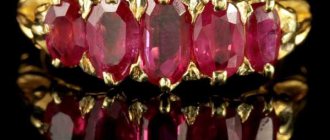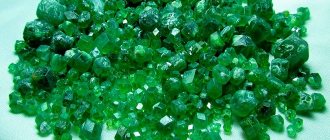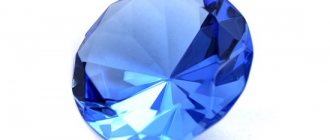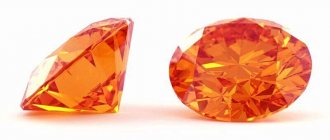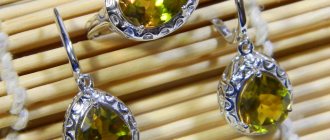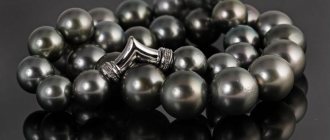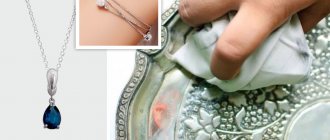Natural minerals are a symbol of strength and natural reliability. Their formation took hundreds and thousands of years, so such crystals can be called real long-livers. Color changing stone is a popular concept that combines precious and semi-precious gemstones with the alexandrite effect.
Such specimens are often called chameleons due to their changeable hue. In this article we will analyze the main types of minerals with this effect and who are suitable for chameleon stones according to their zodiac sign. The rules of care will allow you to preserve the beauty of your jewelry for a long time.
Why do stones change color?
The natural ability of crystals to change color can be called by different names:
- Pleochroism. The mineral changes color when light rays are reflected at different angles. That is, with a slight turn or change of point of view, the shade of the gem changes.
- Alexandrite effect. Implies changes in the color of crystals depending on lighting (daylight, artificial). This effect is also called color reverse. Jewelers use a similar concept when they want to indicate the depth of changes in color (the higher the percentage, the higher the price of such an item).
Note! In everyday communication, all such stones are called “chameleons”. The listed properties can only be found in natural crystals.
Reasons that affect the change in color of the stone:
- Physical. Any natural crystal is a unique combination of chemical elements. One or two basic components form the basis of the stone; the shade and other external characteristics depend on the impurities. Under the influence of humidity, temperature and lighting, special reactions occur between the chemical elements inside the natural crystal, which affects the shade. Radiation and other radiation and viewing angle also play a role.
- Magical. Astrologers and psychics are of the opinion that gemstones change their color when worn depending on the mood of the owner, general health, possible happy events and troubles in the near future. Outside influences also matter - the evil eye, black magic.
There are 2 groups of minerals based on their physical characteristics: the first - stones change color under different lighting (alexandrite, sultanite, tourmaline, amethyst), the second - minerals that change color depending on the increase/decrease in temperature (amethyst, aquamarine).
Properties of chameleon gems
Stones that change color attracted not only fashionistas and naturalists. They were studied by astrologers who tried to establish the effect of these unusual minerals on humans. Moreover, natural sciences in the Middle Ages could not give accurate answers to all questions. Various hypotheses arose, sometimes fantastic, and sometimes having a rational grain.
It was believed that changing the shade of aquamarine depended on changes in a person’s mood. And pyrope is capable of changing its color to a duller one when the person wearing it is physically and mentally exhausted.
According to astrologers, all natural gems have magical properties:
- alexandrite , changing color, predicts significant changes and brings good luck;
- pomegranate lifts your spirits and strengthens self-confidence, helps you achieve your goals, and protects family happiness;
- fire opal protects against the evil eye, develops clairvoyance abilities, strengthens the mind;
- tourmaline protects from enemies, attracts success, develops creativity;
- sapphire is a stone of good luck and prosperity, protects against the evil eye, strengthens the spirit, attracts wealth;
- moonstone protects love, cleanses a person’s aura and removes negative emotions;
- amethyst - reveals hidden talents, promotes harmony in love.
Chameleon stones
Alexandrite
It is the main precious crystal that changes color. Its name is of imperial origin - the mineral was named in honor of the ruler Alexander II. The qualities of a chameleon in this case are due to the unique appearance of the crystal lattice and the presence of iron, titanium and chromium molecules in the composition. From the visible spectrum, such elements perceive only red and green light waves.
In the morning and daytime (with a lot of sun and ultraviolet rays), chromium plays a big role. The hue changes from soft purple to green-blue.
After sunset, infrared radiation predominates, which exhibits the properties of iron. The crystal colors in a crimson range: from crimson to dark red. When using various light filters, alexandrite changes its color to yellow-orange.
Note! The ability of a crystal to change shade under different lighting conditions is recognized as a standard. For this reason, such properties are called the “Alexandrite effect,” regardless of the mineral group of a particular stone.
Alexandrite is a mystery stone, it seems to absorb rays of light, becoming either greenish-blue or reddish-violet...
Published by Jewelry_Gems&Gold Sunday, September 30, 2018
Agate
The crystal belongs to the semi-precious group. It is able to change shade depending on the current state of health of the owner, mood and life circumstances. Agate is also known for its outstanding ability to detect deadly poisons: if something poisonous approaches the owner of the mineral, the stone sharply changes its color.
There is a known case of an agate jewelry that belonged to the famous theosophist Helena Blavatsky. This person was one of the key ones in the scientific community of the 19th century. The lady wore the agate ring as a decoration for a long time, and before leaving for the East she gave it to her sister. After some time, the stone turned completely black. Later it became known that this happened at the time of the death of the owner, thousands of kilometers from home.
Sultanite
Turkish stone is a real treasure of its country and a favorite of the sultans. A mineral can change its own shade under the influence of several factors:
- Amount of light. In low light outdoors or indoors, the crystal looks green, and in bright sunlight it becomes yellow-golden with cognac highlights. In terms of brightness and combination of shades, Turkish stones are more attractive than alexandrite.
- Impurities. The final color of each mineral is determined by impurities, the percentage of additional elements in the composition.
- Frame. This stone can only be set in platinum or high-grade gold - in a simple frame it quickly fades and becomes more cloudy.
Note! Sultanites are mined only in Turkey.
Amethyst
This mineral is a type of natural quartz. The chameleon effect is due to its special composition: inclusions of iron, aluminum and manganese.
Be sure to see: Types, zodiac compatibility and magical properties of green agate
The crystal changes under the influence of 2 factors.
- Lighting. If the oil is in natural light, the stone looks dull and noticeably fades (“daytime” amethysts). “Evening” stones, on the contrary, acquire mysterious shimmers and pronounced shine.
- Temperature conditions. When heated, the crystals become more transparent and lose color saturation. In this case, the purple tint may change to yellow or green. Similar color changes can be noticed upon contact with human skin.
The shimmer in this mineral includes a wide range of shades - from soft blue to dark purple.
Tourmaline
The mineral belongs to the semi-precious category; it is distinguished by inclusions of aluminum and boron compounds. Almost all varieties of tourmaline can boast a chameleon effect.
Under artificial light, the stone appears brown with hints of green and red, and under natural light it turns light pink. For magical recharging and bright shine, this stone needs bright sun.
Topaz
Stones of yellow, blue and pink colors effectively change shades. The stone retains its appearance in any light, but the color saturation may change with prolonged exposure to the sun. In this case, yellow crystals acquire a red tint, and blue and pink crystals become completely discolored.
Opal
Some gems are distinguished by a unique optical effect: light reflections of different colors of the rainbow are noticeable on their surface. This phenomenon is called opalescence.
Attention! Opals of Mexican origin have the most spectacular reflections. The play of shades on the surface of such a crystal resembles a living flame of fire.
The shade of opals can change with sharp fluctuations in air humidity (the approach of a thunderstorm or contact with a source of water). In this case, blue minerals become orange, and red ones acquire a yellow tint.
Moon rock
A stone that changes its hue depending on the phases of the moon. During the new moon, the mineral becomes milky white with minimal shine and shimmer, and closer to the new moon it acquires pronounced transparency.
This phenomenon remains unsolved in the scientific community. Magicians associate with it the great sensitivity of moonstone to all earthly processes. An unexpected change in shade may indicate future danger to the owner.
Aquamarine
A fairly valuable variety of natural beryl, which has a blue-green color. The mineral is capable of gradually changing color as the physical conditions and mood of the owner change.
The smooth rotation of the mineral allows you to see a slight silveriness, which is noticeable from the depths of the stone. When heated, “clumps” of paint and areas of uneven color can be found in the base of the mineral. Exposing the stone to the sun for a long time can cause it to turn yellow and have an earthy tint. When X-rayed, aquamarine appears bright green with small spots.
The mineral is sensitive to the owner’s well-being and the weather. The predominance of a green tint will indicate an imminent storm or the owner’s depressed mood. Cloudiness of the stone indicates possible troubles from other people.
Opal is a stone of different colors, from milky white to black, but with a constant inner rainbow glow.
As a mascot... Posted by Drasopus Thursday, March 23, 2021
Pyrope
It is a special, “ruby” variety of garnet. The color of the stone is provided by compounds of natural manganese, chromium and iron ore. The ratio of such elements in a particular case provides one or another shade. The range of colors is quite wide: from rich red to green and purple.
The stone has earned the name of an energy “barometer”. Upon contact with a strong-willed person who has powerful energy, the stone turns blood red. The lethargy of the owner can make such a mineral dull and inexpressive in color.
The changes in color will be greatest in Madagascar garnets. They can change up to 10 shades per day, which is why they are called “mood crystals.” When approaching equatorial latitudes, the natural play of light in such a stone intensifies.
Note! The listed stones look good as decorations and small talismans.
Pleochroism and stones
In the case of pleochroism (multicolor), the color changes when the stone is viewed from different angles of incidence of the sun's rays or a lamp. Iridescent color includes 2–3 spectrums. The effect is explained by the structure of the crystal lattice and the transparency of the gem.
Varieties of multicolors:
- Facet pleochroism - a change in color is noticeable when viewing a crystal through a flat face.
- Trichroism - 3 colors appear only in biaxial crystals. The palette is viewed from three different angles.
- Dichroism - there are 2 colors of one or two palettes. The first is noticeable when viewing the mineral along the axis, and the second - perpendicular to the line. At other angles, intermediate shades are visible.
- Circular dichroism - two colors present. The color changes when examining part of the stone from the left and right sides of the axis.
There are 5 degrees of pleochroism. The severity can be weak, medium, moderate-strong, strong and extreme. The last (ultimate) dichroism is found in Riesling-beryl.
A video will complement the topic:
Chameleon stones with pronounced trichroism, and a range of changing colors:
- alexandrite - green, ruby, orange with a red tint;
- axinite - olive, brown with red and yellow tints;
- kyanite - transparent, blue with violet and cobalt color;
- topaz - yellow, purple, blue or pink;
- chrome diopside - green, yellow, red.
Among chameleons, benitoite and tourmaline exhibit dichroism. The first mineral is rare, similar to blue sapphire. When changing the angle, indigo, purple or greenish color is visible.
With dichroism, pink tourmalines show colorlessness and red hues. The brown mineral at the corners has a yellowish, greenish tint. Yellow, green, purple or blue stones have a dark tone of the main color on one side, and a pale color on the other.
In the video, jewelry owners demonstrate how the gem changes shades:
The color of the stones and the mood of the owner
Lithotherapists are confident that some natural stones can change their color under the influence of the owner’s emotions and mood:
- if the shade of the stone, when worn constantly, begins to predominate green, this indicates a deterioration in the mood, depression of the owner.
- if a transparent gem becomes cloudy and loses its glow, we can talk about disappointment in the owner’s soul (love torments, depression).
Note! Aquamarine and moonstone react most actively to the owner’s emotions. They are capable of changing under the influence of the energy of a particular person. !
Stone care
Most often, gems of this order do not react very well to the effects of temperature and bright sunlight. Therefore, you need to take some precautions when caring for them. The basic content rules include:
- Limiting interaction with sunlight, storing only in closed cells or bags;
- No more durable neighbors that can scratch the crystal;
- Using only lukewarm water and soap to clean;
- Ban on the use of chemical cleaning agents;
- Use a soft cloth or sponge when washing;
- Removing jewelry with volatile minerals when cooking, cleaning, applying cosmetics and hair products.
Following these simple rules will allow you to preserve the quality of the chameleon mineral for a long time.
Who is suitable for volatile minerals?
Stones that change shades can become excellent talismans and amulets:
- Alexandrite will harmonize with the internal energy of people who were born under the constellations of Aquarius, Leo, Gemini and Scorpio. The power of the gem will give them the necessary energy, help them make responsible decisions and find peace of mind.
- Ruby and sapphire patronize Cancers, Pisces and Aquarius. Such stones will attract good luck and success in all endeavors.
- Amethyst is suitable for Gemini, Libra and Aquarius. It helps to establish relationships with others and gain social recognition.
- Opal harmonizes with the internal energy of Scorpios and Pisces. The mineral helps get rid of internal torment and mental tension.
Important! When choosing a suitable setting for a stone, it is worth considering the energy of the chosen metal.
Do you have a stone with a changeable shade - a chameleon?
Not really
How to preserve the original appearance of gems?
Any gemstone that changes color needs careful care and compliance with certain rules that will help avoid damage and turbidity. These include the following:
- It is recommended to store products with minerals in tight jewelry bags. This is necessary in order to protect them from ultraviolet radiation.
- Avoid large temperature changes (heat and frost). The same applies to air flows, so when drying your hair with a hot hairdryer, earrings with gems should be removed in advance.
- Protect from contact with chemical compounds and cosmetics.
- Periodically place them in a solution with salt to get rid of accumulated negative energy.
- Before cleaning and taking a bath, accessories should be removed so as not to damage them.
If you are a fan of unusual accessories made from natural minerals, then you will certainly like chameleon gems. The main thing is to select stones not only according to your zodiac sign, but also according to your taste preferences, so that you can wear them as favorite jewelry. They can not only cheer up their owner, but also add a touch of brightness and courage to her image.
21.11.20
How to care for chameleons
With prolonged wear, chameleon stones can lose their shine, become dull and dirty. To return them to their original shine, you need to immerse the gem in a warm solution based on liquid soap for 15-20 minutes. The use of abrasive substances for cleaning is highly undesirable!
Be sure to see: Pink agate, origin, properties, areas of use
You can also clean the crystals using a soft cloth. Rinse the product with water and wipe it dry using polishing movements. In this case, you can process not only the crystal, but also the metal frame - this will give the product additional shine and beauty.
Important! This method is not suitable for soft sultanite. This stone is very fragile and vulnerable, so any mechanical impact can damage its surface, causing scratches and abrasions.
To prevent damage to stones, you need to follow some rules:
- Gems should be stored in individual canvas bags that will protect them from sunlight;
- chameleon minerals must be protected from the effects of temperature changes and strong heating. For this reason, you should not wear products with such stones for long walks in frost or high solar activity;
- Do not expose the crystals to hot air, otherwise cracks may form (be sure to remove earrings when drying your hair with a hairdryer);
- apply perfumes and decorative cosmetics before putting on jewelry, this will help protect the stones from stains and excess dirt, contact with chemicals;
- minerals should not be exposed to household chemicals, chemical solvents, etc. During cleaning and various works, stones should be removed (this rule especially applies to rings and bracelets on hands)
Important! Since natural stones are prone to the accumulation of negative energy, they need a regular cleansing procedure. To do this, place the products in a container with fine table salt. After a few minutes, the minerals can be removed and rinsed with water. The salt must be thrown away after this.
What is best to combine with
Bright and iridescent minerals in jewelry are good on their own and do not need neighbors, or they can be combined with stones that are calmer in color and influence.
Under no circumstances should 2 or more volatile minerals be used in one product, so as not to provoke a “conflict”. The color of other crystals in the decoration should only emphasize the beauty of the main element, highlight it and create a background. For the same reason, it is better to choose silver or white gold as a frame; the yellow version can “block” all the charm of the chameleon, drawing attention to itself. It is also worth considering that some specimens will change shade to a less attractive one when the lighting changes.
As for clothing, stylists advise wearing jewelry with changeable stones in combination with outfits in calm colors. Plain fabrics will create the right background and make the crystal the main element of the wardrobe, attracting everyone's attention to it. Chameleons are best suited for evening wear, but can also be combined with simple styles of daywear. In some cases, you can wear jewelry with an iridescent gem with elaborate outfits, but the main thing is to observe moderation, then combine it with a product that is simple in cut and frame.
Main conclusions
Natural stones are associated with permanence, but some specimens can change their color. These crystals are called chameleon crystals and are often used in jewelry. Gems reflect the mood, emotions and state of the owner. Mineral lovers have 2 options for explaining these properties:
- physical. Chemical elements in natural minerals can change their properties under the influence of different lighting, temperature or air humidity;
- magical. Such stones have particularly strong energy, thanks to which they can capture the internal state of the owner and predict possible failures and difficulties in life.
Chameleon stones are wonderful talismans and amulets for different zodiac signs. If you want to enjoy the beauty of your jewelry for a long time, do not forget about the rules for cleaning and storing such items. .
Do you have jewelry/talismans made from stones that change color? Share in the comments what frame you prefer for chameleon jewelry and whether you feel the influence of multicolor amulets!
Terms
Let's try to figure out the name of a stone that changes color. This phenomenon has several official names:
- Plechroism is the ability of a nugget to change color when a stream of light is reflected in a different direction.
- The Alexandrite effect is a transformation of the color of the mineral in the event of a change in lighting. This same phenomenon is called color reverse. The term is popular in the jewelry industry, where transformation of the color of a stone is possible under artificial lighting conditions. The depth of change is measured as a percentage. The higher the percentage, the more expensive the nugget.
Ordinary people call such stones chameleons.
Main varieties and colors
Opal has about 100 varieties, which are divided into two groups:
- ordinary (semi-precious) minerals;
- noble (precious) stones.
Each of these groups includes a large number of stones with different physical characteristics, descriptions and uses.
Gems
Precious types of opals include the following minerals:
- Fire stones have a characteristic color, shades of which vary from yellowish wine to deep red. Most samples do not have an opalescent effect. The only exception is minerals mined in Mexico.
- Black opal is a rare and expensive mineral. It does not have to be black in color. It can be dark blue, dark gray, dark purple or dark green. All stones have clear rainbow highlights.
- Harlequin, like the clothing of a literary hero, has many multi-colored inclusions. The bulk of the mineral has an absolutely colorless transparent structure. It is quite difficult to answer what color this opal has, since it shimmers with all the colors of the rainbow.
- The cat's eye is honey-yellow in color with a vertical stripe down the middle.
- Royal opal has a rich color consisting of a bright red center and a green border.
- Lejos opal is a precious gem that has a bright bluish-green color with carmine tints.
- Girasol - “sunny stone”. It is a transparent mineral with bluish wavy tints.
Common opals
Cheap jewelry and interior decorations are made from ordinary stones. Examples of semi-precious stones are the following minerals:
- Cacholong is an ornamental stone that is a fusion of three minerals: opal, chalcedony and quartz. The white mineral has a smooth porcelain surface of gray color with a blue or yellow tint.
- Hydrophane is a mineral belonging to the opal group. In its normal state, the stone has a smoky milky tint, but when immersed in water it becomes transparent with rainbow tints. By looking at the stone at this moment, you can understand what color it is opal.
- Chrysopal is an opaque mineral that can be colored in various shades of green. It is considered one of the most durable representatives of opals. It is used to make inexpensive jewelry and various souvenirs.
- Dendrite opal was formed by filling the trunks of dead trees with the substance. At the same time, all longitudinal and transverse details of the wood structure were preserved. Minerals of unusual type are used in jewelry production, and inexpensive original jewelry is made from them.
- Wax opals are silicas that have an opaque, smooth structure. They are colored yellowish-brown and have a characteristic waxy sheen.
How to distinguish natural sultanite from a fake
To meet demand, natural sultanite is not only replaced with synthetic, but also counterfeited - instead of the iridescent chameleon stone, they are trying to sell fakes made of glass or even plastic. Of course, the appearance of such specimens is very far from what a natural gem looks like. But anything can happen: sometimes buyers trust sellers and are ready to buy even a crude fake.
There is a way to help recognize a fake. Take a photo of the stone you are going to buy and look at the photo. If the stone has a clearly defined color in the photograph, then this is a fake. A real crystal does not have one specific color - it shimmers in different colors.
When you are looking at jewelry in an untrusted store or souvenir shop, compare the model you like with others - if all the sultanites look the same, without defects and uniform color, then they are probably fakes.
Natural sultanite is a piece stone; it is not supplied in batches of the same fraction. Finding several minerals of the same size and color for decoration is incredible luck, which is why diaspores are most often used for pendants and solitaire rings. For earrings or necklaces with many identical inserts, synthetic sultanites are usually used.
Description of the stone
The name comes from the peninsula in northeastern Canada where it was first discovered in the late 18th century. In everyday life it is also called labradorite. Although this is actually a term for the igneous rock from which it is extracted (it must contain at least 60% labradorite).
This is a semi-precious ornamental stone, in its raw form an opaque mineral with a matte glass luster. Color range: gray, gray-green, up to blue-black.
Labradorite as a mineral is a type of feldspar with various impurities. Quite fragile: easily splits, crumbles, melts and dissolves in acids.
Its peculiarity is the effect of iridization or “labradorization” - a peculiar iridescence of all the colors of the rainbow on the surface of the mineral. It can be continuous or partial, focal in the form of spots or even patterns. It is created by the crystalline structure of the stone or inclusions of ilmenite. This is the product of hot lava, a fiery element that melted many rocks. Therefore, the properties of the stone are multifaceted and unusual.
Synthetic Slocum Stones
Initially, the American Slocum wanted to create an imitation of opal that would replicate its chemical composition. However, as a result of experiments with silicate materials, he created a special glass, which in appearance resembles a natural gem, but is stronger than it. Differences can only be noticed with high magnification.
In Slocum's synthetic stones, iridescent iridescent spots resemble a scattering of triangles. In natural gemstones they are flat and have a velvety shine.
Slocum opal.
